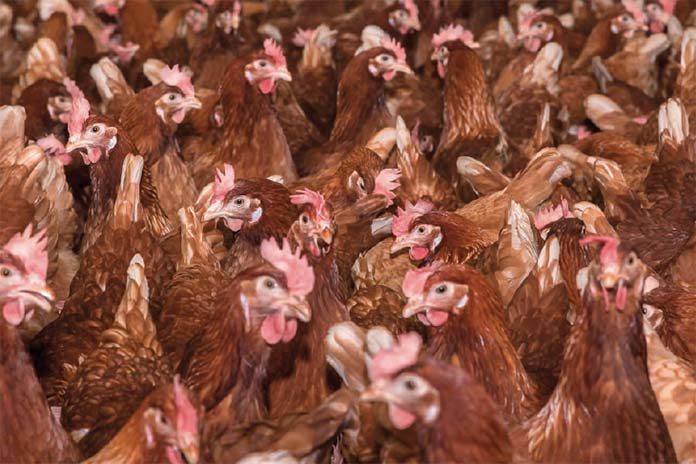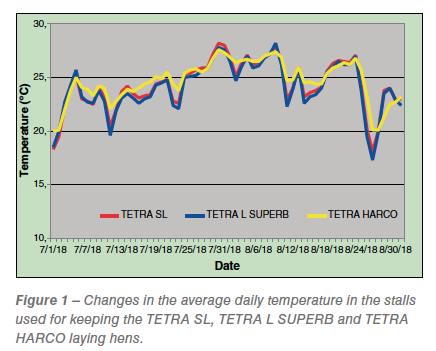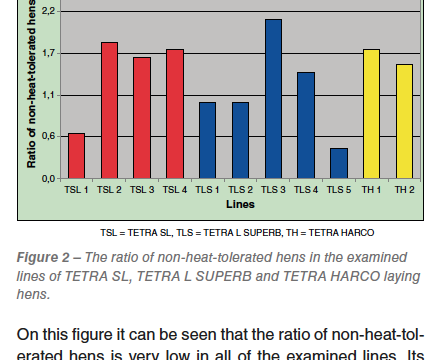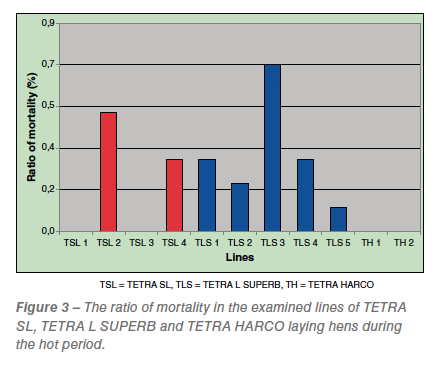
The global warming and the climate change affect animal production and sustainability of livestock systems. The high ambient temperature has detrimental effect on the performance of laying hens.
The heat stress is one of the major challenges for the poultry industry, especially in the tropical and subtropical regions. Because the Bábolna TETRA Ltd. exports its layers to more than fifty – among of them to several tropical and subtropical – countries worldwide, the aim of the present study was to evaluate the performance of the different TETRA pedigree lines under hot climate conditions.
The examination was carried out between the 1st of July and 31st of August in 2018 in two different stalls of the Bábolna TETRA Ltd. One of these stalls was divided into two parts, where the TETRA SL and TETRA L SUPERB pure lines were placed separately (TETRA SL in the one part and TETRA L SUPERB in the other part). The other stall was used for keeping the TETRA HARCO pure lines.
The inside temperature of the premises was measured continuously and recorded at every 10 minutes during the examined period. Based on these data the average daily temperature was calculated in all of the examined stalls. In Figure 1 it can be seen that the hot period, when the average daily temperature continuously exceeded the 25 ºC, was between the 24th of July and 10th of August in all cases. Therefore, this period was chosen for the examination of the heat tolerance of the examined lines.

In this period the egg production intensity was calculated individually for each hen. This egg production intensity was compared with the egg production intensity before and after the hot period. Because the hot period lasted until 18 days, similar long periods were chosen before and after the hot period (6-23 July and 11-28 August, respectively) for the evaluation of the egg production of the hens. Those hens, which production intensity decreased by more than 20% in the hot period and increased by more than 20% thereafter, were decided as non-heat-tolerated hens. On Figure 2 the ratio of these hens is visible in all of the examined lines.

On this figure it can be seen that the ratio of non-heat-tolerated hens is very low in all of the examined lines. Its value exceeded the 2% only in TLS 3 (2.1%), while its value was under 2% in all of the other lines. The best results were found around 0.5% both in the TETRA SL and TETRA L SUPERB hens (0.6% in TSL 1 and 0.4% in TLS 5, respectively). In the examined HARCO lines the ratio of non-heat-tolerated hens was around 1.5% (1.7% in TH 1 and 1.5% in TH 2, respectively).
The ratio of mortality showed also very favourable values during the hot period in all of the examined lines (Figure 3).

No mortality was observed in the two examined HARCO lines (TH 1 and TH 2) and in two of the four examined TETRA SL lines (TSL 1 and TSL 3). The worst result was obtained in one of the examined TETRA L SUPERB lines (TLS 3), but its value remained also under 1% (0.7%).
Based on these results it can be stated that the Bábolna TETRA Ltd. has a very good genetic base for producing heat-tolerated laying hens also for the markets in the hot climates.
Acknowledgment
This research was supported by the project ‘GINOP-2.3.4-15-2016-00005’ project, co-funded from EU sources and European Structural and Investment Funds and the Hungarian State.
The publication of the research was supported by the project ‘EFOP-3.6.3 VEKOP-16-2017-00008 2.3.4-15-2016-00005’ co-funded from EU sources and European Social Investment Funds and the Hungarian State.
















